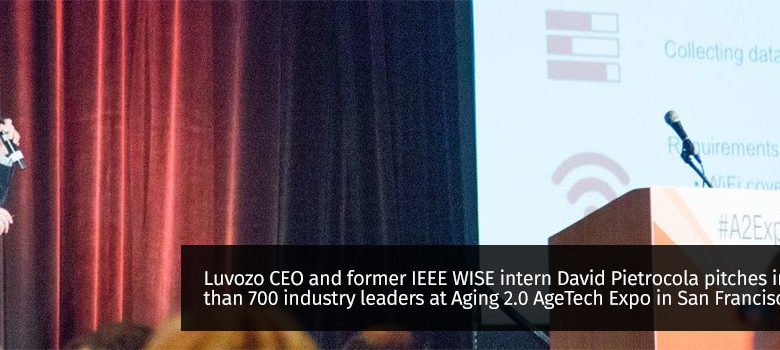
Since his undergraduate days at Trinity College in Hartford, Conn., David Pietrocola has believed in the promise of robotics to help others. While studying for his B.S. in electrical engineering, he led a 15-member student team in the school’s famed International Robot Contest, which connects robotics to individuals with disabilities.
Although not yet 30, this ambitious and energetic entrepreneur is chief executive officer and co-founder of Luvozo PBC, in Washington, D.C. Launched in mid-2013, the company is developing assistive technologies to provide residents of assisted-living and skilled-nursing facilities with improved safety and overall care.
 |
A four-foot tall robot named SAM is the first product that Pietrocola and Jude Kessler, his business partner, have developed. They created their “Robotic Concierge”⢠to increase regular, personalized resident check-ins and interactions–whether it’s to remind residents about meals and activities; monitor non-intrusively individuals with a high-fall risk; or reduce response time to patient requests–a leading complaint among assisted-living and skilled-nursing residents.
The facility staff prepares and customizes the schedule SAM follows for each resident. State-of-the-art technology and a map of the facility help SAM automatically make scheduled itinerary visits to each resident. The robot uses sensors and redundant safety systems to move about without staff intervention. Upon arriving at each person’s room, the large display screen atop each system enables trained, off-site care professionals to connect through SAM to provide individualized check-ins.
During mid-2015, Pietrocola and Kessler successfully tested the robotic system in the Mid-Atlantic region, as well as on the West Coast. Now, they are fine-tuning production processes, and preparing to start installing their Robotic Concierge in facilities in mid-2016.
“We’ve had a great response, especially from the elderly residents,” says Pietrocola. “They enjoyed having SAM around, saying it became a part of their community. When we removed them after the test deployments, some residents asked to get the robots back, because they missed them!”
Just as important, administrators of the facilities where the robots were tested were enthusiastic about how cost-effective robotic technologies can improve care and resident satisfaction. When production is underway, the Robotic Concierge should be priced at less than $5.00 an hour.
An IEEE Member since he was at Trinity, Pietrocola is convinced that much of an engineer’s purpose is to create a better world. In 2007, while on his path toward this objective, he experienced first-hand the intersection between engineering and public policy issues as an IEEE participant in the Washington Internships for Students of Engineering (WISE) program. After receiving his M.S. at the University of Pennsylvania, he decided he wanted to start having a direct impact on people’s lives. In Washington, D.C., Pietrocola worked as a science analyst for the National Science Foundation, where he gained insights on how grants are made.
In early 2013, Pietrocola and a group of engineering friends met to discuss how they could take robotics out of the lab and commercialize it to help improve people’s quality of life. Working with personnel from United Cerebral Palsy, they examined the need for solutions for individuals with limited mobility.
“We got good feedback that we wanted to turn into a company that could make a difference,” he says.
Next, with the support of a business incubator run by D.C.-area universities and the National Science Foundation, Pietrocola and his colleagues spoke to dozens of potential customers, including nursing home administrators. This hands-on research made them realize the enormous business and social opportunities in helping seniors.
“Every day,” he says, “10,000 Americans are turning 65–and 70 percent of them will require long-term care at some point; whether it’s recovering after a surgery, or for a longer stay.” But he says that rising costs, staff turnover and competition make it difficult for senior living communities to improve resident care and satisfaction–which is where technology can help.
With a recent grant from the Small Business Innovation Research (SBIR) program, Pietrocola and his team are working to ensure that SAM and future Luvozo products will help to protect seniors from falls–and their frequently life-changing consequences.
“Falls are a major issue with older adults,” he says, “and regular checks in residential facilities can reduce falls by half.” Luvozo is developing a sensor suite that looks for environmental hazards as it moves around. Pietrocola says robotics can detect such environmental hazards as clutter, spacing between furniture, and low-contrast changes from carpet to bare floors, among other dangers. The company is developing fall-prevention software for potential use in homes and hospitals, and using a tablet or smartphone.
Pietrocola is quick to point out that Luvozo is a public benefit corporation (PBC). “This means our mission to improve the quality of life is at the core of our structure,” he says. “We’re not just a company that exists to make profits. It’s a constant reminder to us, and to our potential customers, of our mission.”
He attributes his entrepreneurial instincts, at least in part, to heredity. Pietrocola’s parents, who emigrated from Italy, own a company in New York that distributes ornamental steel and hardware. “My father was a fabricator by training, and he and my mother transformed their business to become a nationwide industry player,” he says. “They taught me a lot about hard work.”
Helen Horwitz is an award-winning freelance writer who lives in Albuquerque, N.M. She was with IEEE from 1991 through 2011, the first nine as Staff Director, IEEE Corporate Communications.






